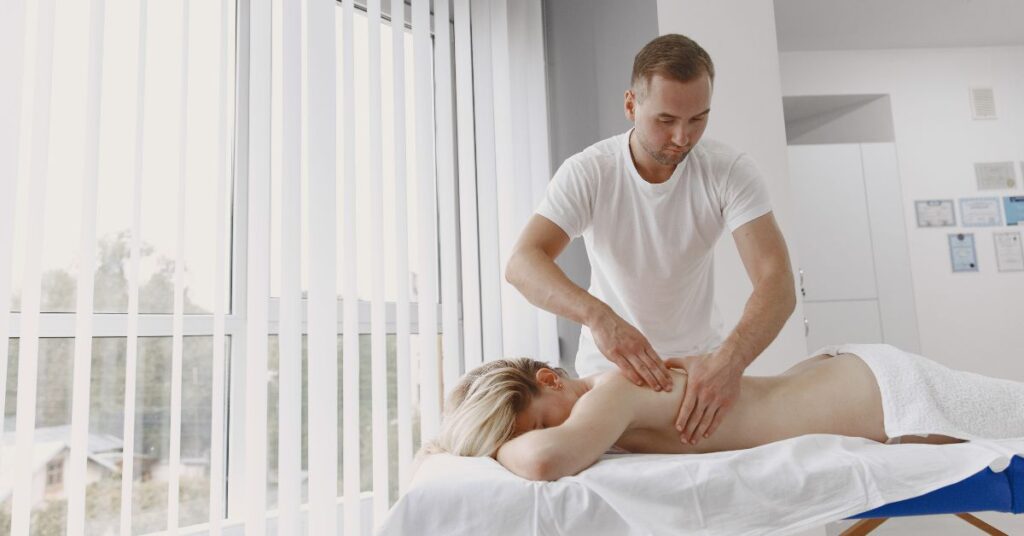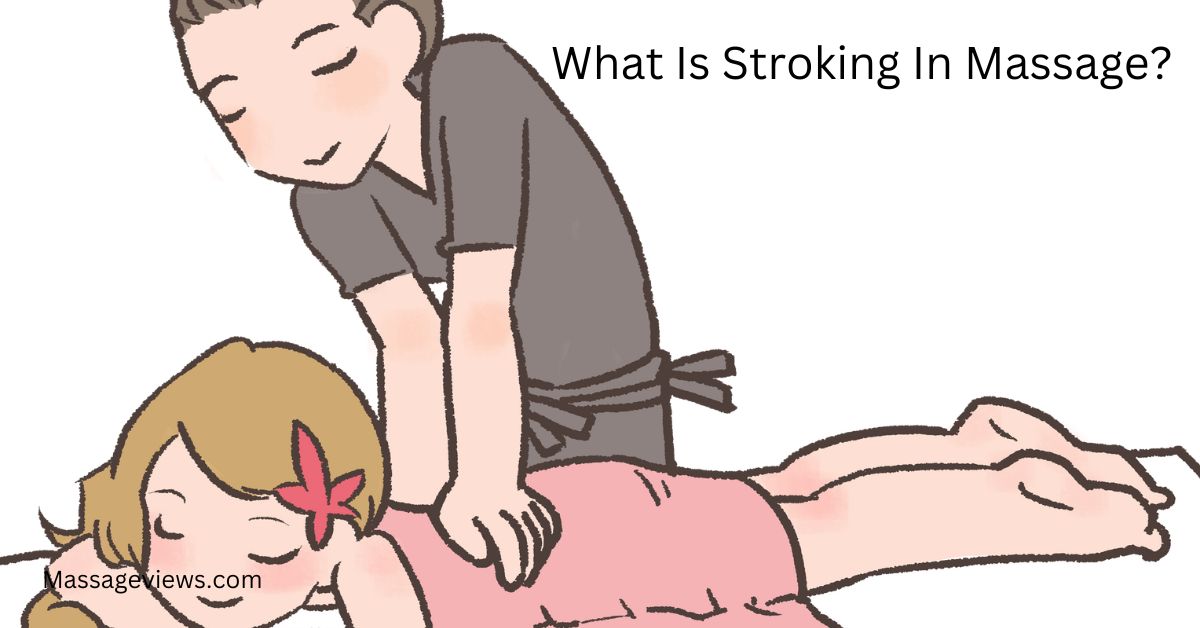Effleurage, commonly known as stroking in massage therapy, embodies a fundamental technique revered for its ability to induce relaxation and improve circulation. In this article, we delve into the essence of stroking, its purpose, benefits, technique, application, and precautions, shedding light on its significance within the realm of massage therapy. Let’s explore the gentle yet powerful strokes that form the cornerstone of this therapeutic practice.
Table of Contents
Purpose and Benefits
Increases Blood Flow
Stroking, or effleurage, catalyzes enhancing blood circulation within the body. The rhythmic motion of the strokes effectively directs blood flow along the pathways of the muscles. By facilitating improved circulation, this technique ensures a more efficient delivery of nutrients and oxygen to various tissues and organs throughout the body, fostering overall health and vitality.
Stretches Tissues
The gentle, gliding strokes of effleurage provide a subtle yet effective stretch to muscles, tendons, and fascia. This elongation helps to alleviate tension and stiffness within the soft tissues, enhancing flexibility and promoting a wider range of motion. Through this stretching action, effleurage contributes to the maintenance of optimal muscle function and joint mobility, facilitating a greater sense of ease and comfort within the body.

Relaxes the Client
Effleurage, with its rhythmic and soothing motions, serves as a potent tool for inducing a state of deep relaxation in massage clients. The gentle and consistent strokes help to calm the nervous system, easing tension and promoting a sense of tranquility. By fostering relaxation, effleurage enables clients to unwind both physically and mentally, allowing them to release stress and experience a profound sense of serenity during the massage session.
Aids Dispersal of Waste Products
Effleurage plays a crucial role in enhancing the body’s natural detoxification process by facilitating the dispersal of metabolic waste products. Through improved lymphatic drainage, this massage technique helps to remove toxins and excess fluids from the tissues, promoting a healthier internal environment. Additionally, effleurage assists in the elimination of accumulated lactic acid in the muscles, reducing soreness and promoting faster recovery after physical activity.
Further reading: When massage is painful?
Technique and Application
Hand Motion
Effleurage employs long, smooth, and gliding strokes executed with light to medium pressure. Practitioners maintain constant contact with the client’s skin throughout the massage, ensuring a seamless flow of motion. This gentle yet purposeful hand movement enhances relaxation and encourages the body to respond positively to the therapeutic touch, making effleurage a cornerstone technique in massage therapy.
Direction
Effleurage involves applying strokes in a deliberate direction, typically either distal to proximal or proximal to distal, depending on the desired effect. These directional movements help to optimize the flow of blood and lymphatic fluid within the body, promoting circulation and enhancing the massage experience. By adhering to specific stroke directions, massage therapists can effectively target areas of tension and encourage the body’s natural healing processes.
Areas Treated
Effleurage is commonly employed on large muscle groups such as the back, legs, and arms, where it can effectively relieve tension and promote relaxation. Additionally, it serves as a transitional stroke between different massage techniques, ensuring a smooth and seamless flow throughout the session. By addressing key muscle areas, effleurage maximizes its therapeutic benefits, leaving clients feeling rejuvenated and revitalized after their massage experience.
Contraindications and Cautions
Areas of Inflammation or Infection
It’s crucial to exercise caution when applying effleurage to areas of the body experiencing inflammation or infection. Direct messages on inflamed or infected areas can exacerbate discomfort and potentially spread the infection.
However, gently stroking around these areas can help improve circulation and aid in the body’s natural healing process. Massage therapists should assess the client’s condition thoroughly and adjust their techniques accordingly to ensure a safe and beneficial treatment session.
Open Wounds
Massage therapists must avoid massaging directly over open wounds, cuts, or sores to prevent contamination and further injury. Direct contact with open wounds can introduce bacteria and other pathogens, leading to infection and delaying the healing process.
Instead, therapists should carefully work around these areas, applying effleurage strokes to adjacent healthy tissue to promote circulation and support the body’s healing mechanisms. Prioritizing client safety and maintaining hygiene protocols are essential in providing effective and responsible massage therapy.
Special Health Conditions
When using effleurage on clients who have certain medical issues, like varicose veins or deep vein thrombosis (DVT), massage therapists should use caution. Avoiding forceful strokes that could loosen blood clots is crucial in DVT instances to avoid major consequences. Similarly, to prevent aggravating discomfort or further damaging the veins in customers with varicose veins, mild effleurage strokes should be used in the direction of blood flow.
To guarantee the safety and efficacy of massage therapy for people with specific health concerns, it is imperative to conduct a complete evaluation of the client’s medical history and to speak with a healthcare provider beforehand.
Concluding
In the field of massage treatment, effleurage, or stroking, is a fundamental and adaptable method that provides a host of advantages to customers looking to unwind, revitalize, and relieve tension. Effleurage, with its deliberate yet soft strokes, promotes general health and vigor by improving blood circulation, stretching tissues, promoting relaxation, and assisting in the dispersal of waste products.
Although effleurage has great therapeutic potential, massage therapists need to be cautious and modify their methods for clients who have certain medical issues or should not use it. Effleurage continues to be a safe, efficient, and essential part of massage therapy because it prioritizes the safety of its clients and customizes treatments to meet their specific needs.
FAQ
Is effleurage suitable for everyone?
Effleurage is generally safe for most individuals, but it’s essential to consider specific health conditions or contraindications. Consulting with a qualified massage therapist can help determine if effleurage is appropriate for your individual needs.
Can effleurage help with muscle soreness or stiffness?
Yes, effleurage can be beneficial for relieving muscle soreness and stiffness by promoting relaxation, improving circulation, and gently stretching the tissues. However, for specific concerns, it’s advisable to consult with a trained massage therapist to determine the most appropriate treatment approach.
Can effleurage help with stress relief and relaxation?
Yes, effleurage is renowned for its ability to induce relaxation and alleviate stress. The gentle, rhythmic strokes promote a sense of tranquility and calm, making it an excellent choice for individuals seeking relaxation and stress relief. Incorporating effleurage into a massage session can help promote overall well-being and mental relaxation.
Are there any side effects associated with effleurage?
Effleurage is generally considered safe, but some individuals may experience mild soreness or sensitivity following a massage session, especially if they’re new to massage therapy or have sensitive skin. It’s essential to communicate any discomfort or concerns with your massage therapist to ensure a comfortable and effective treatment experience.
